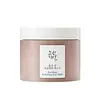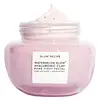What's inside
What's inside
 Key Ingredients
Key Ingredients

 Benefits
Benefits

 Concerns
Concerns

 Ingredients Side-by-side
Ingredients Side-by-side

Water
Skin ConditioningGlycerin
HumectantKaolin
AbrasiveCaprylic/Capric Triglyceride
Masking1,2-Hexanediol
Skin ConditioningPhaseolus Angularis Seed Powder
Hectorite
AbsorbentCetyl Alcohol
EmollientGlyceryl Stearate Se
EmulsifyingCetearyl Olivate
Sorbitan Olivate
EmulsifyingPhaseolus Angularis Seed Extract
AntioxidantUltramarines
Pyrus Communis Fruit Extract
Skin ConditioningEthylhexylglycerin
Skin ConditioningSodium Acrylate/Sodium Acryloyldimethyl Taurate Copolymer
Emulsion StabilisingHedera Helix Leaf/Stem Extract
AntimicrobialPolyisobutene
Fragaria Chiloensis Fruit Extract
Skin ConditioningPyrus Malus Leaf Extract
Skin ConditioningCI 77491
Cosmetic ColorantCaprylyl/Capryl Glucoside
CleansingSorbitan Oleate
EmulsifyingTriethoxycaprylylsilane
Water, Glycerin, Kaolin, Caprylic/Capric Triglyceride, 1,2-Hexanediol, Phaseolus Angularis Seed Powder, Hectorite, Cetyl Alcohol, Glyceryl Stearate Se, Cetearyl Olivate, Sorbitan Olivate, Phaseolus Angularis Seed Extract, Ultramarines, Pyrus Communis Fruit Extract, Ethylhexylglycerin, Sodium Acrylate/Sodium Acryloyldimethyl Taurate Copolymer, Hedera Helix Leaf/Stem Extract, Polyisobutene, Fragaria Chiloensis Fruit Extract, Pyrus Malus Leaf Extract, CI 77491, Caprylyl/Capryl Glucoside, Sorbitan Oleate, Triethoxycaprylylsilane
Water
Skin ConditioningGlycerin
HumectantKaolin
AbrasiveStearyl Alcohol
EmollientHydroxypropyl Starch Phosphate
Bentonite
AbsorbentCaprylic/Capric Triglyceride
MaskingGlyceryl Stearate Se
EmulsifyingCitrullus Lanatus Fruit Extract
Skin ConditioningGluconolactone
Skin ConditioningHydrated Silica
AbrasiveSea Water
HumectantSalix Alba Bark Extract
AstringentSodium Stearoyl Lactylate
EmulsifyingXanthan Gum
EmulsifyingLactobacillus/Watermelon Fruit Ferment Extract
Skin ConditioningSodium Hyaluronate
HumectantHydrolyzed Sodium Hyaluronate
Skin ConditioningBambusa Arundinacea Stem Extract
Skin ConditioningLycium Barbarum Fruit Extract
AstringentLeuconostoc/Radish Root Ferment Filtrate
AntimicrobialCaprylyl Glycol
Emollient1,2-Hexanediol
Skin ConditioningCitric Acid
BufferingMaltodextrin
AbsorbentEclipta Prostrata Extract
Skin ConditioningGlucose
HumectantSodium Phytate
Silica
AbrasiveMelia Azadirachta Leaf Extract
Skin ConditioningPotassium Sorbate
PreservativeHexylene Glycol
EmulsifyingMoringa Oleifera Seed Oil
EmollientVaccinium Corymbosum Seed
AbrasiveHydroxyacetophenone
AntioxidantCarrageenan
CI 77891
Cosmetic ColorantPhenoxyethanol
PreservativeParfum
MaskingWater, Glycerin, Kaolin, Stearyl Alcohol, Hydroxypropyl Starch Phosphate, Bentonite, Caprylic/Capric Triglyceride, Glyceryl Stearate Se, Citrullus Lanatus Fruit Extract, Gluconolactone, Hydrated Silica, Sea Water, Salix Alba Bark Extract, Sodium Stearoyl Lactylate, Xanthan Gum, Lactobacillus/Watermelon Fruit Ferment Extract, Sodium Hyaluronate, Hydrolyzed Sodium Hyaluronate, Bambusa Arundinacea Stem Extract, Lycium Barbarum Fruit Extract, Leuconostoc/Radish Root Ferment Filtrate, Caprylyl Glycol, 1,2-Hexanediol, Citric Acid, Maltodextrin, Eclipta Prostrata Extract, Glucose, Sodium Phytate, Silica, Melia Azadirachta Leaf Extract, Potassium Sorbate, Hexylene Glycol, Moringa Oleifera Seed Oil, Vaccinium Corymbosum Seed, Hydroxyacetophenone, Carrageenan, CI 77891, Phenoxyethanol, Parfum
 Reviews
Reviews

Ingredients Explained
These ingredients are found in both products.
Ingredients higher up in an ingredient list are typically present in a larger amount.
1,2-Hexanediol is a synthetic liquid and another multi-functional powerhouse.
It is a:
- Humectant, drawing moisture into the skin
- Emollient, helping to soften skin
- Solvent, dispersing and stabilizing formulas
- Preservative booster, enhancing the antimicrobial activity of other preservatives
This ingredient is an emollient, solvent, and texture enhancer. It is considered a skin-softener by helping the skin prevent moisture loss.
It helps thicken a product's formula and makes it easier to spread by dissolving clumping compounds.
Caprylic Triglyceride is made by combining glycerin with coconut oil, forming a clear liquid.
While there is an assumption Caprylic Triglyceride can clog pores due to it being derived from coconut oil, there is no research supporting this.
Learn more about Caprylic/Capric TriglycerideGlycerin is already naturally found in your skin. It helps moisturize and protect your skin.
A study from 2016 found glycerin to be more effective as a humectant than AHAs and hyaluronic acid.
As a humectant, it helps the skin stay hydrated by pulling moisture to your skin. The low molecular weight of glycerin allows it to pull moisture into the deeper layers of your skin.
Hydrated skin improves your skin barrier; Your skin barrier helps protect against irritants and bacteria.
Glycerin has also been found to have antimicrobial and antiviral properties. Due to these properties, glycerin is often used in wound and burn treatments.
In cosmetics, glycerin is usually derived from plants such as soybean or palm. However, it can also be sourced from animals, such as tallow or animal fat.
This ingredient is organic, colorless, odorless, and non-toxic.
Glycerin is the name for this ingredient in American English. British English uses Glycerol/Glycerine.
Learn more about GlycerinGlyceryl Stearate Se is a self-emulsifying (SE) form of glyceryl stearate. Self-emusifying means this ingredient automatically blends with water. It is an emulsifier, emollient, and cleansing agent.
As an emulsifier, Glyceryl Stearate Se prevents ingredients such as oil and water from separating. It is also a surfactant, meaning it helps cleanse the skin. Surfactants help gather oil, dirt, and other pollutants so they may be rinsed away easily.
Emollients help your skin stay smooth and soft. It does so by creating a film on top of the skin that helps trap moisture in.
Learn more about Glyceryl Stearate SeKaolin is a clay. It is used for oil control and to help minimize pores. Like other clays, kaolin has the ability to absorb excess sebum or oil. This can help clean out pores and mattify the skin.
Some types of kaolin may have exfoliating properties. When water is added to kaolin, it becomes a paste with small abrasive particles.
Most kaolin is a white color, but may be pink/orange/red depending on where it comes from.
The name 'kaolin' comes from a Chinese village named 'Gaoling'. Kaolin clay comes from rocks rich in kaolinite. Kaolinite, the mineral, has a silicate layered structure. Kaolinite is formed from chemical weathering of aluminum siilicate minerals.
Besides skincare, kaolin is commonly used to make glossy paper, in ceramics, toothpaste, and as medicine to soothe stomach issues.
Learn more about KaolinWater. It's the most common cosmetic ingredient of all. You'll usually see it at the top of ingredient lists, meaning that it makes up the largest part of the product.
So why is it so popular? Water most often acts as a solvent - this means that it helps dissolve other ingredients into the formulation.
You'll also recognize water as that liquid we all need to stay alive. If you see this, drink a glass of water. Stay hydrated!
Learn more about Water